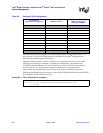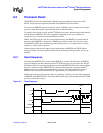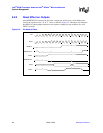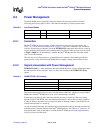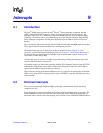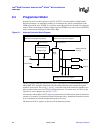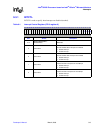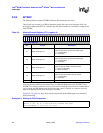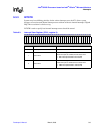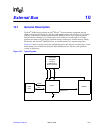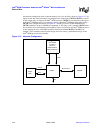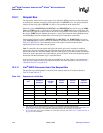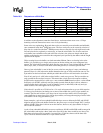
9-4 March, 2003 Developer’s Manual
Intel
®
80200 Processor based on Intel
®
XScale
™
Microarchitecture
Interrupts
9.3.2 INTSRC
The Interrupt Source register (INTSRC) indicates which interrupts are active.
This register may be used by an ISR to determine quickly the source of an interrupt. Even if an
interrupt is masked with INTCTL, software may still detect whether it is asserted by reading its bit
from INTSRC.
Note that memory buffering and external logic on FIQ# and IRQ# could cause INTSRC.II and
INTSRC.FI to remain asserted for several cycles after the interrupt source has been commanded to
stop asserting. An ISR should ensure that the interrupt source is quelled, or a spurious recursive
entry to the ISR may result when interrupts are enabled.
Example 9-1 on page 9-4, shows how software might wait for the FIQ# signal to be deasserted
before proceeding.
Table 9-2. Interrupt Source Register (CP13, register 4)
31 30 29 28 27 26 25 24 23 22 21 20 19 18 17 16 15 14 13 12 11 10 9 8 7 6 5 4 3 2 1 0
F
I
I
I
B
I
P
I
reset value: undefined
Bits Access Description
31 Read / Write-ignored
FI - FIQ# active
Holds the state of the synchronized FIQ# signal.
0 = not interrupting
1 = interrupting
30 Read / Write-ignored
II - IRQ# active
Holds the state of the synchronized IRQ# signal.
0 = not interrupting
1 = interrupting
29 Read / Write-ignored
BI - BCU Interrupt Active
Holds the state of the BCU interrupt request.
0 = BCU not interrupting
1 = BCU interrupting
28 Read / Write-ignored
PI -PMU Interrupt Active
Holds the state of the PMU interrupt request.
0 = not interrupting
1 = interrupting
27:0 Read-unpredictable / Write-ignored Reserved
Example 9-1. Waiting for FIQ# Deassertion
waitForNoFIQ:
MRC P13, 0, R15, C4, C0, 0; get high bits of INTSRC into flags
BMI waitForNoFIQ; if FI bit set, try again



